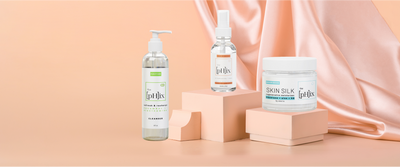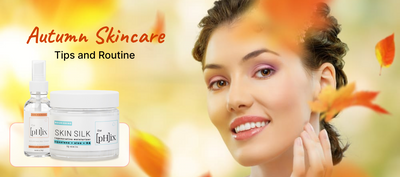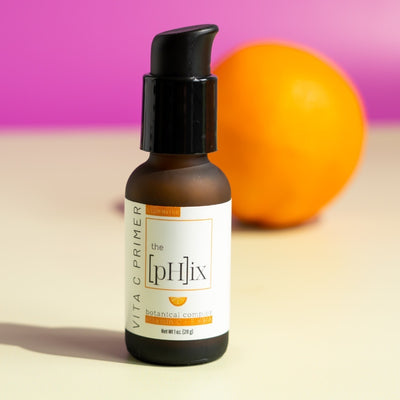Discover The Phix Blogs Here
Here we spread and share our skincare knowledge with you!
Featured Blog Posts

Essential Steps for a Summer Acne-Clearing Routine
Summer is a time for sunshine, outdoor activities, and fun, but it can also be a challenging season for those with acne-prone skin. The combination of increased heat, humidity, and sun exposure often leads to more frequent breakouts and clogged pores. If you're looking for ways to keep your skin clear and healthy during these warm months, you're in the right place. In this guide, we'll walk you through the essential steps for a summer acne-clearing routine. By understanding the unique challenges posed by summer weather and using the right skincare products, you can maintain a clear, radiant complexion all season long. Let's dive into a routine that will help you enjoy the best of summer without worrying about acne. Step 1: Start with a Gentle Cleanser Cleanser A gentle cleanser is crucial for removing sweat, dirt, and excess oil without stripping your skin of its natural moisture. For effective acne clearing, look for products containing salicylic acid or benzoyl peroxide, which help unclog pores and prevent new breakouts. Usage Tips: When to Use: Morning and evening. How to Use: Use lukewarm water to open pores and enhance cleansing. Gently massage the cleanser into your skin for 30 seconds before rinsing thoroughly. Step 2: Apply a Clarifying Toner Toners Toners play a vital role in balancing the skin's pH and removing any residual impurities after cleansing. Choose a toner with exfoliating properties to keep pores clear and reduce the risk of breakouts, an essential step in acne clearing. Usage Tips: When to Use: Morning and evening after cleansing. How to Use: Apply best vitamin c toner with a cotton pad, sweeping it over your face and neck. Focus on acne-prone areas such as the forehead, nose, and chin. Step 3: Hydrate with a Lightweight Moisturizer Moisturizer Even oily and acne-prone skin needs hydration. Opt for a lightweight, non-comedogenic moisturizer that won't clog pores but will keep your skin balanced and hydrated, aiding in acne clearing. Usage Tips: When to Use: Morning and evening after toner. How to Use: Apply moisturizer, focusing on dry areas. Use a small amount to avoid overloading your skin. Step 4: Protect with Broad-Spectrum Sunscreen Sunscreen Sun protection is crucial for preventing hyperpigmentation products and further skin damage. Choose a broad-spectrum sunscreen with at least SPF 30, specifically formulated for acne-prone skin to assist in acne clearing. Usage Tips: When to Use: Every morning as the last step in your routine. How to Use: Apply sunscreen generously over your face. Reapply every two hours when exposed to direct sunlight. Ensure thorough coverage, including the ears and neck. Step 5: Exfoliate Weekly Exfoliation Regular exfoliation helps remove dead skin cells and prevent clogged serum for acne scars and pores. However, avoid over-exfoliating, which can irritate the skin and exacerbate acne, a key consideration in your acne clearing routine. Usage Tips: When to Use: Once or twice a week, depending on your skin's tolerance. How to Use: Gently massage the scrub into your skin for about a minute. Rinse thoroughly with lukewarm water and follow with toner and moisturizer. Step 6: Apply Targeted Treatments Acne Treatments For persistent breakouts, incorporate targeted treatments into your routine. Products with benzoyl peroxide, salicylic acid, or sulfur can effectively treat active acne spots, enhancing your acne clearing efforts. Usage Tips: When to Use: After cleansing and toning. How to Use: Apply the treatment directly to blemishes. Use sparingly, as these treatments can be drying. Follow with moisturizer to maintain skin hydration. Step 7: Maintain a Healthy Lifestyle Lifestyle Tips In addition to a robust skincare routine, maintaining a healthy lifestyle significantly impacts your skin's health and supports acne clearing. Consider these tips: Stay Hydrated: Drink plenty of water throughout the day to keep your skin hydrated from within. Balanced Diet: Eat a diet rich in fruits, vegetables, and lean proteins. Avoid excessive consumption of sugary and greasy foods. Regular Exercise: Exercise helps increase blood flow and promotes Healthy & Glowing Skin. Cleanse your skin immediately after sweating. Reduce Stress: High stress levels can trigger acne. Practice stress-reducing activities such as yoga, meditation, or spending time in nature. Conclusion Achieving clear skin during the summer months requires a dedicated skincare routine tailored to address the unique challenges posed by heat and humidity. By following these essential steps—using a gentle cleanser, applying a clarifying toner, hydrating with a lightweight moisturizer, protecting with broad-spectrum sunscreen, exfoliating weekly, and incorporating targeted treatments—you can keep acne at bay and enjoy a radiant complexion all summer long. Consistency is key, and combining these steps with a healthy lifestyle will maximize your results.
Essential Steps for a Summer Acne-Clearing Routine
Summer is a time for sunshine, outdoor activities, and fun, but it can also be a challenging season for those with acne-prone skin. The combination of increased heat, humidity, and sun exposure often leads to more frequent breakouts and clogged pores. If you're looking for ways to keep your skin clear and healthy during these warm months, you're in the right place. In this guide, we'll walk you through the essential steps for a summer acne-clearing routine. By understanding the unique challenges posed by summer weather and using the right skincare products, you can maintain a clear, radiant complexion all season long. Let's dive into a routine that will help you enjoy the best of summer without worrying about acne. Step 1: Start with a Gentle Cleanser Cleanser A gentle cleanser is crucial for removing sweat, dirt, and excess oil without stripping your skin of its natural moisture. For effective acne clearing, look for products containing salicylic acid or benzoyl peroxide, which help unclog pores and prevent new breakouts. Usage Tips: When to Use: Morning and evening. How to Use: Use lukewarm water to open pores and enhance cleansing. Gently massage the cleanser into your skin for 30 seconds before rinsing thoroughly. Step 2: Apply a Clarifying Toner Toners Toners play a vital role in balancing the skin's pH and removing any residual impurities after cleansing. Choose a toner with exfoliating properties to keep pores clear and reduce the risk of breakouts, an essential step in acne clearing. Usage Tips: When to Use: Morning and evening after cleansing. How to Use: Apply best vitamin c toner with a cotton pad, sweeping it over your face and neck. Focus on acne-prone areas such as the forehead, nose, and chin. Step 3: Hydrate with a Lightweight Moisturizer Moisturizer Even oily and acne-prone skin needs hydration. Opt for a lightweight, non-comedogenic moisturizer that won't clog pores but will keep your skin balanced and hydrated, aiding in acne clearing. Usage Tips: When to Use: Morning and evening after toner. How to Use: Apply moisturizer, focusing on dry areas. Use a small amount to avoid overloading your skin. Step 4: Protect with Broad-Spectrum Sunscreen Sunscreen Sun protection is crucial for preventing hyperpigmentation products and further skin damage. Choose a broad-spectrum sunscreen with at least SPF 30, specifically formulated for acne-prone skin to assist in acne clearing. Usage Tips: When to Use: Every morning as the last step in your routine. How to Use: Apply sunscreen generously over your face. Reapply every two hours when exposed to direct sunlight. Ensure thorough coverage, including the ears and neck. Step 5: Exfoliate Weekly Exfoliation Regular exfoliation helps remove dead skin cells and prevent clogged serum for acne scars and pores. However, avoid over-exfoliating, which can irritate the skin and exacerbate acne, a key consideration in your acne clearing routine. Usage Tips: When to Use: Once or twice a week, depending on your skin's tolerance. How to Use: Gently massage the scrub into your skin for about a minute. Rinse thoroughly with lukewarm water and follow with toner and moisturizer. Step 6: Apply Targeted Treatments Acne Treatments For persistent breakouts, incorporate targeted treatments into your routine. Products with benzoyl peroxide, salicylic acid, or sulfur can effectively treat active acne spots, enhancing your acne clearing efforts. Usage Tips: When to Use: After cleansing and toning. How to Use: Apply the treatment directly to blemishes. Use sparingly, as these treatments can be drying. Follow with moisturizer to maintain skin hydration. Step 7: Maintain a Healthy Lifestyle Lifestyle Tips In addition to a robust skincare routine, maintaining a healthy lifestyle significantly impacts your skin's health and supports acne clearing. Consider these tips: Stay Hydrated: Drink plenty of water throughout the day to keep your skin hydrated from within. Balanced Diet: Eat a diet rich in fruits, vegetables, and lean proteins. Avoid excessive consumption of sugary and greasy foods. Regular Exercise: Exercise helps increase blood flow and promotes Healthy & Glowing Skin. Cleanse your skin immediately after sweating. Reduce Stress: High stress levels can trigger acne. Practice stress-reducing activities such as yoga, meditation, or spending time in nature. Conclusion Achieving clear skin during the summer months requires a dedicated skincare routine tailored to address the unique challenges posed by heat and humidity. By following these essential steps—using a gentle cleanser, applying a clarifying toner, hydrating with a lightweight moisturizer, protecting with broad-spectrum sunscreen, exfoliating weekly, and incorporating targeted treatments—you can keep acne at bay and enjoy a radiant complexion all summer long. Consistency is key, and combining these steps with a healthy lifestyle will maximize your results.

Why Does Your Skin Get Drier in the Fall?
When autumn arrives, you might notice your skin feeling dry, tight, or flaky. This is a common experience for many people as the seasons change. Understanding why this happens can help you take steps to keep your skin soft and healthy during the fall. Let's explore the reasons behind dry skin in autumn and learn simple ways to prevent it. Why Does Fall Make Your Skin Dry? Several factors contribute to drier skin during the fall season. Here's what happens: 1. Cooler Air Has Less Moisture Less Humidity: In the summer, the air is warm and holds more moisture. When fall comes, the air becomes cooler and can't hold as much water. Effect on Skin: Dry air pulls moisture from your skin. This makes your skin feel dry and sometimes rough. 2. Indoor Heating Dries Out the Air Heating Systems: As it gets colder, we turn on heaters to keep our homes warm. Effect on Skin: Heaters make the indoor air drier. Dry indoor air can lead to dry skin because there's less moisture around you. 3. Hot Showers and Baths Comforting Warmth: Taking hot showers or baths feels nice when it's chilly outside. Effect on Skin: Hot water can wash away natural oils that protect your skin, making it easier for your skin to lose moisture. 4. Cold Wind and Weather Chilly Winds: Fall often brings windy and cold days. Effect on Skin: Wind can strip moisture from your skin and cause irritation or redness. 5. Wearing Certain Clothes Warm Clothing: We wear sweaters, scarves, and other warm clothes. Effect on Skin: Some fabrics, like wool, can irritate the skin and make dryness worse. Signs That Your Skin Is Dry It's important to recognize when your skin is dry so you can take action. Here are common signs: Tight Feeling: Your skin feels stretched, especially after washing. Flakiness: Small pieces of dry skin peel off, making your skin look flaky. Itching: Dry skin can make you feel itchy. Redness: Your skin may look red or feel irritated. Cracks: Small cracks or lines appear, often on your hands or lips. How to Keep Your Skin Moisturized in Fall You can take simple steps to protect your skin from drying out: 1. Stay Hydrated Drink Water: Aim to drink plenty of water each day to keep your body hydrated. Eat Water-Rich Foods: Include fruits and vegetables like cucumbers, oranges, and watermelon in your diet. 2. Adjust Your Skincare Routine Use Gentle Cleansers: Choose mild soaps or cleansers that don't strip away your skin's natural oils. Moisturize Regularly: Apply lotion or cream after washing your face or hands to lock in moisture. Add Hydrating Serums: Products like niacinamide serum can help your skin retain moisture. 3. Protect Your Skin Barrier Apply Sunscreen: Even in fall, the sun's rays can affect your skin. Use sunscreen with at least SPF 30. Use Lip Balm: Keep your lips from chapping by applying a moisturizing lip balm. Avoid Harsh Products: Stay away from skincare products with alcohol or strong fragrances that can dry out your skin. 4. Take Warm, Not Hot, Showers Shorter Showers: Limit your shower time to 5-10 minutes. Use Warm Water: Hot water can dry out your skin, so use warm water instead. Gently Pat Dry: After bathing, gently pat your skin with a towel instead of rubbing it. 5. Use a Humidifier at Home Add Moisture to the Air: A humidifier puts water back into the air, helping to keep your skin hydrated. Ideal Indoor Humidity: Aim for indoor humidity levels between 30% and 50%. 6. Dress to Protect Your Skin Wear Protective Clothing: Gloves, scarves, and hats can shield your skin from cold air and wind. Choose Soft Fabrics: Wear clothes made from cotton or silk, which are gentle on the skin. Layer Up: Dressing in layers helps you stay warm without overheating, which can affect your skin. Skincare Products That Can Help Using the right skincare products can make a big difference: Niacinamide Serum What It Does: Strengthens the skin barrier, helps retain moisture, and reduces redness. How to Use It: After washing your face, apply a few drops of niacinamide serum before moisturizing. Caffeine Eye Cream What It Does: Caffeine eye cream reduces puffiness and dark circles around the eyes, hydrates delicate skin. How to Use It: Gently tap a small amount around your eyes in the morning and before bed. Vitamin C Serum What It Does: Vitamin C Serum protects your skin from environmental damage, brightens complexion, and boosts collagen production. How to Use It: Apply a few drops to your face in the morning after cleansing and before applying moisturizer and sunscreen. Simple Tips for Healthy Skin This Fall Don't Forget Sunscreen: UV rays can still harm your skin in the fall. Apply sunscreen daily. Stay Active: Exercise improves blood flow, which can help your skin look healthy. Get Enough Sleep: Rest allows your skin to repair itself. Manage Stress: Stress can affect your skin. Try activities like reading, drawing, or deep breathing to relax. Consult a Professional: If dry skin persists, consider talking to a dermatologist for personalized advice. Enjoy the Fall Season with Healthy Skin Dry skin doesn't have to be a part of your fall experience. By understanding why your skin gets dry and making small changes to your routine, you can keep your skin feeling comfortable and looking great all season long. Remember: Stay Hydrated: Drink water and eat hydrating foods. Moisturize: Use lotions and creams regularly. Protect Your Skin: Wear protective clothing and use gentle skincare products. Ready to keep your skin soft and hydrated this fall? Explore our specially formulated skincare products: Niacinamide Serum: Strengthens and moisturizes your skin. Caffeine Eye Cream: Keeps the delicate skin around your eyes healthy. Vitamin C Serum: Protects and brightens your skin.
Why Does Your Skin Get Drier in the Fall?
When autumn arrives, you might notice your skin feeling dry, tight, or flaky. This is a common experience for many people as the seasons change. Understanding why this happens can help you take steps to keep your skin soft and healthy during the fall. Let's explore the reasons behind dry skin in autumn and learn simple ways to prevent it. Why Does Fall Make Your Skin Dry? Several factors contribute to drier skin during the fall season. Here's what happens: 1. Cooler Air Has Less Moisture Less Humidity: In the summer, the air is warm and holds more moisture. When fall comes, the air becomes cooler and can't hold as much water. Effect on Skin: Dry air pulls moisture from your skin. This makes your skin feel dry and sometimes rough. 2. Indoor Heating Dries Out the Air Heating Systems: As it gets colder, we turn on heaters to keep our homes warm. Effect on Skin: Heaters make the indoor air drier. Dry indoor air can lead to dry skin because there's less moisture around you. 3. Hot Showers and Baths Comforting Warmth: Taking hot showers or baths feels nice when it's chilly outside. Effect on Skin: Hot water can wash away natural oils that protect your skin, making it easier for your skin to lose moisture. 4. Cold Wind and Weather Chilly Winds: Fall often brings windy and cold days. Effect on Skin: Wind can strip moisture from your skin and cause irritation or redness. 5. Wearing Certain Clothes Warm Clothing: We wear sweaters, scarves, and other warm clothes. Effect on Skin: Some fabrics, like wool, can irritate the skin and make dryness worse. Signs That Your Skin Is Dry It's important to recognize when your skin is dry so you can take action. Here are common signs: Tight Feeling: Your skin feels stretched, especially after washing. Flakiness: Small pieces of dry skin peel off, making your skin look flaky. Itching: Dry skin can make you feel itchy. Redness: Your skin may look red or feel irritated. Cracks: Small cracks or lines appear, often on your hands or lips. How to Keep Your Skin Moisturized in Fall You can take simple steps to protect your skin from drying out: 1. Stay Hydrated Drink Water: Aim to drink plenty of water each day to keep your body hydrated. Eat Water-Rich Foods: Include fruits and vegetables like cucumbers, oranges, and watermelon in your diet. 2. Adjust Your Skincare Routine Use Gentle Cleansers: Choose mild soaps or cleansers that don't strip away your skin's natural oils. Moisturize Regularly: Apply lotion or cream after washing your face or hands to lock in moisture. Add Hydrating Serums: Products like niacinamide serum can help your skin retain moisture. 3. Protect Your Skin Barrier Apply Sunscreen: Even in fall, the sun's rays can affect your skin. Use sunscreen with at least SPF 30. Use Lip Balm: Keep your lips from chapping by applying a moisturizing lip balm. Avoid Harsh Products: Stay away from skincare products with alcohol or strong fragrances that can dry out your skin. 4. Take Warm, Not Hot, Showers Shorter Showers: Limit your shower time to 5-10 minutes. Use Warm Water: Hot water can dry out your skin, so use warm water instead. Gently Pat Dry: After bathing, gently pat your skin with a towel instead of rubbing it. 5. Use a Humidifier at Home Add Moisture to the Air: A humidifier puts water back into the air, helping to keep your skin hydrated. Ideal Indoor Humidity: Aim for indoor humidity levels between 30% and 50%. 6. Dress to Protect Your Skin Wear Protective Clothing: Gloves, scarves, and hats can shield your skin from cold air and wind. Choose Soft Fabrics: Wear clothes made from cotton or silk, which are gentle on the skin. Layer Up: Dressing in layers helps you stay warm without overheating, which can affect your skin. Skincare Products That Can Help Using the right skincare products can make a big difference: Niacinamide Serum What It Does: Strengthens the skin barrier, helps retain moisture, and reduces redness. How to Use It: After washing your face, apply a few drops of niacinamide serum before moisturizing. Caffeine Eye Cream What It Does: Caffeine eye cream reduces puffiness and dark circles around the eyes, hydrates delicate skin. How to Use It: Gently tap a small amount around your eyes in the morning and before bed. Vitamin C Serum What It Does: Vitamin C Serum protects your skin from environmental damage, brightens complexion, and boosts collagen production. How to Use It: Apply a few drops to your face in the morning after cleansing and before applying moisturizer and sunscreen. Simple Tips for Healthy Skin This Fall Don't Forget Sunscreen: UV rays can still harm your skin in the fall. Apply sunscreen daily. Stay Active: Exercise improves blood flow, which can help your skin look healthy. Get Enough Sleep: Rest allows your skin to repair itself. Manage Stress: Stress can affect your skin. Try activities like reading, drawing, or deep breathing to relax. Consult a Professional: If dry skin persists, consider talking to a dermatologist for personalized advice. Enjoy the Fall Season with Healthy Skin Dry skin doesn't have to be a part of your fall experience. By understanding why your skin gets dry and making small changes to your routine, you can keep your skin feeling comfortable and looking great all season long. Remember: Stay Hydrated: Drink water and eat hydrating foods. Moisturize: Use lotions and creams regularly. Protect Your Skin: Wear protective clothing and use gentle skincare products. Ready to keep your skin soft and hydrated this fall? Explore our specially formulated skincare products: Niacinamide Serum: Strengthens and moisturizes your skin. Caffeine Eye Cream: Keeps the delicate skin around your eyes healthy. Vitamin C Serum: Protects and brightens your skin.

Fall Skincare Tips: 9 Best Steps for an Autumn Skincare Routine
As the leaves change color and the air turns crisp, your skin might start to feel different. Fall brings cooler temperatures and drier air, which can affect your skin's health. But don't worry! By adjusting your skincare routine, you can keep your skin soft, hydrated, and glowing all season long. This guide will walk you through the 9 best steps for an effective autumn skincare routine. Why Does Fall Affect Your Skin? In autumn, the air becomes cooler and holds less moisture. Indoor heating can also dry out the air inside your home. These changes can make your skin feel dry, tight, or flaky. Understanding how the season affects your skin helps you take the right steps to protect it. Step 1: Use a Gentle Cleanser Cleansing your skin removes dirt and impurities. In the fall, it's important to use a gentle cleanser that doesn't strip away your skin's natural oils. Why? Harsh cleansers can make your skin drier. Tip: Look for cleansers labeled "gentle" or "hydrating." How to Use: Wash your face with lukewarm water and gently massage the cleanser onto your skin. Rinse thoroughly. Step 2: Exfoliate Gently Exfoliating removes dead skin cells, helping your skin look fresh and smooth. Why? Dead skin can build up in dry weather, making your skin look dull. Tip: Use a gentle exfoliant once or twice a week. Product Suggestion: Try a PHA Toner. PHAs (polyhydroxy acids) are gentle and suitable for sensitive skin. How to Use: After cleansing, apply the PHA toner to a cotton pad and gently swipe over your face, avoiding the eye area. Step 3: Apply a Hyaluronic Acid Serum Hyaluronic acid helps your skin retain moisture, keeping it hydrated. Why? It attracts water to your skin, making it look plump and healthy. Tip: Apply the serum after cleansing and before moisturizing. Product Suggestion: Our Hyaluronic Acid Serum adds extra hydration. How to Use: Place a few drops on your fingertips and gently press into your skin. Step 4: Incorporate a Vitamin C Serum Vitamin C brightens your skin and protects it from environmental damage. Why? It boosts collagen production and fights free radicals. Tip: Use it in the morning after cleansing. Product Suggestion: Try our Vitamin C Serum for a radiant complexion. How to Use: Apply a few drops to your face and neck, avoiding the eye area. Step 5: Moisturize with a Rich Cream A thicker moisturizer provides a protective barrier to lock in moisture. Why? Your skin needs extra hydration in dry, cool air. Tip: Look for moisturizers with ingredients like ceramides and shea butter. Product Suggestion: Our Skin Silk Moisturizer nourishes and softens your skin. How to Use: Gently massage onto your face and neck after applying serums. Step 6: Always Wear Sunscreen Even though the sun feels less intense, harmful UV rays are still present. Why? UV damage can occur year-round and contribute to skin aging. Tip: Use a broad-spectrum sunscreen with at least SPF 30 every day. How to Use: Apply generously to all exposed skin after moisturizing and before going outside. Step 7: Introduce a PHA Toner A PHA toner gently exfoliates and hydrates your skin. Why? PHAs are suitable for sensitive skin and help remove dead skin cells without irritation. Tip: Use it to prepare your skin for better absorption of serums and moisturizers. Product Suggestion: Our PHA Toner refreshes your skin gently. How to Use: After cleansing, apply the toner with a cotton pad, avoiding the eye area. Step 8: Care for Your Lips and Hands Your lips and hands can become very dry in the fall. Why? They have thinner skin and lose moisture quickly. Tip: Use lip balm and hand cream regularly. How to Use: Apply lip balm throughout the day and hand cream after washing your hands. Step 9: Stay Hydrated and Eat Healthy Foods Good hydration and nutrition support your skin from the inside out. Why? Water and nutrients help maintain skin elasticity and glow. Tip: Drink plenty of water and eat fruits and vegetables rich in vitamins. Examples: Foods like oranges, spinach, and nuts are great choices. FAQs about Fall Skincare Q1: How often should I exfoliate in the fall? A: Exfoliate once or twice a week with a gentle exfoliant to avoid over-irritating your skin. Q2: Should I change my moisturizer for fall? A: Yes, using a richer moisturizer helps combat the drier air and keeps your skin hydrated. Q3: Is sunscreen necessary in autumn? A: Absolutely! UV rays can still damage your skin, so continue using sunscreen daily. Q4: What is a PHA toner, and why should I use it? A: A PHA toner gently exfoliates dead skin cells while hydrating your skin. It's ideal for sensitive skin types. Q5: How can I prevent chapped lips in the fall? A: Apply a moisturizing lip balm regularly, especially before going outside, to protect your lips from drying out. Conclusion Adjusting your skincare routine for fall is essential to keep your skin healthy and glowing. By following these 9 steps, you can protect your skin from dryness and embrace the beauty of the season with confidence. Remember: Use gentle products that hydrate your skin. Protect your skin from environmental factors like dry air and UV rays. Nourish your skin from the inside with proper hydration and nutrition. Enhance Your Autumn Skincare Routine with Our Products Hyaluronic Acid Serum: Deep hydration for plump, healthy-looking skin. Vitamin C Serum: Brightens and protects your complexion. Skin Silk Moisturizer: Rich nourishment to lock in moisture. PHA Toner: Gentle exfoliation for a refreshed feel. Explore our full range of skincare products to keep your skin radiant all year round.
Fall Skincare Tips: 9 Best Steps for an Autumn Skincare Routine
As the leaves change color and the air turns crisp, your skin might start to feel different. Fall brings cooler temperatures and drier air, which can affect your skin's health. But don't worry! By adjusting your skincare routine, you can keep your skin soft, hydrated, and glowing all season long. This guide will walk you through the 9 best steps for an effective autumn skincare routine. Why Does Fall Affect Your Skin? In autumn, the air becomes cooler and holds less moisture. Indoor heating can also dry out the air inside your home. These changes can make your skin feel dry, tight, or flaky. Understanding how the season affects your skin helps you take the right steps to protect it. Step 1: Use a Gentle Cleanser Cleansing your skin removes dirt and impurities. In the fall, it's important to use a gentle cleanser that doesn't strip away your skin's natural oils. Why? Harsh cleansers can make your skin drier. Tip: Look for cleansers labeled "gentle" or "hydrating." How to Use: Wash your face with lukewarm water and gently massage the cleanser onto your skin. Rinse thoroughly. Step 2: Exfoliate Gently Exfoliating removes dead skin cells, helping your skin look fresh and smooth. Why? Dead skin can build up in dry weather, making your skin look dull. Tip: Use a gentle exfoliant once or twice a week. Product Suggestion: Try a PHA Toner. PHAs (polyhydroxy acids) are gentle and suitable for sensitive skin. How to Use: After cleansing, apply the PHA toner to a cotton pad and gently swipe over your face, avoiding the eye area. Step 3: Apply a Hyaluronic Acid Serum Hyaluronic acid helps your skin retain moisture, keeping it hydrated. Why? It attracts water to your skin, making it look plump and healthy. Tip: Apply the serum after cleansing and before moisturizing. Product Suggestion: Our Hyaluronic Acid Serum adds extra hydration. How to Use: Place a few drops on your fingertips and gently press into your skin. Step 4: Incorporate a Vitamin C Serum Vitamin C brightens your skin and protects it from environmental damage. Why? It boosts collagen production and fights free radicals. Tip: Use it in the morning after cleansing. Product Suggestion: Try our Vitamin C Serum for a radiant complexion. How to Use: Apply a few drops to your face and neck, avoiding the eye area. Step 5: Moisturize with a Rich Cream A thicker moisturizer provides a protective barrier to lock in moisture. Why? Your skin needs extra hydration in dry, cool air. Tip: Look for moisturizers with ingredients like ceramides and shea butter. Product Suggestion: Our Skin Silk Moisturizer nourishes and softens your skin. How to Use: Gently massage onto your face and neck after applying serums. Step 6: Always Wear Sunscreen Even though the sun feels less intense, harmful UV rays are still present. Why? UV damage can occur year-round and contribute to skin aging. Tip: Use a broad-spectrum sunscreen with at least SPF 30 every day. How to Use: Apply generously to all exposed skin after moisturizing and before going outside. Step 7: Introduce a PHA Toner A PHA toner gently exfoliates and hydrates your skin. Why? PHAs are suitable for sensitive skin and help remove dead skin cells without irritation. Tip: Use it to prepare your skin for better absorption of serums and moisturizers. Product Suggestion: Our PHA Toner refreshes your skin gently. How to Use: After cleansing, apply the toner with a cotton pad, avoiding the eye area. Step 8: Care for Your Lips and Hands Your lips and hands can become very dry in the fall. Why? They have thinner skin and lose moisture quickly. Tip: Use lip balm and hand cream regularly. How to Use: Apply lip balm throughout the day and hand cream after washing your hands. Step 9: Stay Hydrated and Eat Healthy Foods Good hydration and nutrition support your skin from the inside out. Why? Water and nutrients help maintain skin elasticity and glow. Tip: Drink plenty of water and eat fruits and vegetables rich in vitamins. Examples: Foods like oranges, spinach, and nuts are great choices. FAQs about Fall Skincare Q1: How often should I exfoliate in the fall? A: Exfoliate once or twice a week with a gentle exfoliant to avoid over-irritating your skin. Q2: Should I change my moisturizer for fall? A: Yes, using a richer moisturizer helps combat the drier air and keeps your skin hydrated. Q3: Is sunscreen necessary in autumn? A: Absolutely! UV rays can still damage your skin, so continue using sunscreen daily. Q4: What is a PHA toner, and why should I use it? A: A PHA toner gently exfoliates dead skin cells while hydrating your skin. It's ideal for sensitive skin types. Q5: How can I prevent chapped lips in the fall? A: Apply a moisturizing lip balm regularly, especially before going outside, to protect your lips from drying out. Conclusion Adjusting your skincare routine for fall is essential to keep your skin healthy and glowing. By following these 9 steps, you can protect your skin from dryness and embrace the beauty of the season with confidence. Remember: Use gentle products that hydrate your skin. Protect your skin from environmental factors like dry air and UV rays. Nourish your skin from the inside with proper hydration and nutrition. Enhance Your Autumn Skincare Routine with Our Products Hyaluronic Acid Serum: Deep hydration for plump, healthy-looking skin. Vitamin C Serum: Brightens and protects your complexion. Skin Silk Moisturizer: Rich nourishment to lock in moisture. PHA Toner: Gentle exfoliation for a refreshed feel. Explore our full range of skincare products to keep your skin radiant all year round.
All Posts

how to apply our long lasting, water-based vitamin c primer?
one of our main differentiators is that
how to apply our long lasting, water-based vitamin c primer?
one of our main differentiators is that

launch day
“a thank you & an explanation”
 is here! Shop now, pay later in 4 easy installments
is here! Shop now, pay later in 4 easy installments
